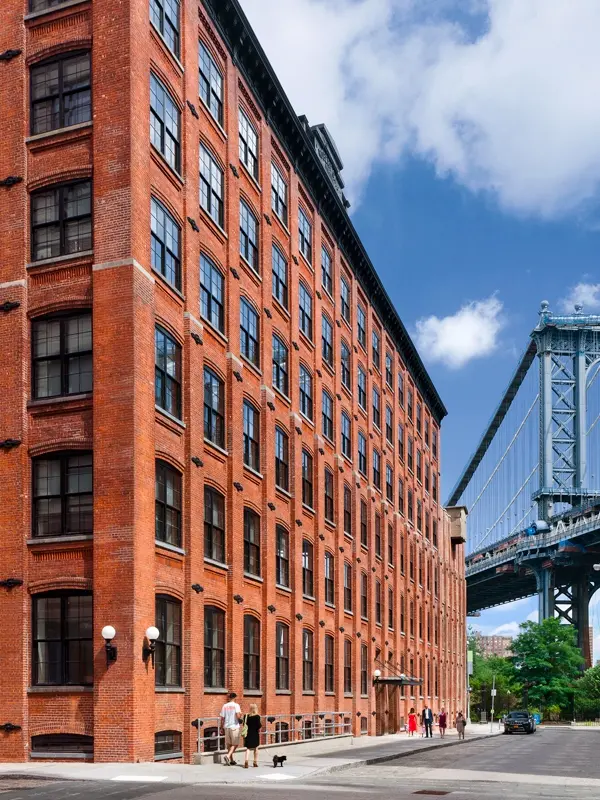30 Washington Street: Review and Ratings
at The corner of Water Street View Full Building Profile


This very handsome, 7-story rental building at 30 Washington Street in the Dumbo section of Brooklyn was originally erected in 1930 as part of a waterfront, industrial complex by Robert Gair and was converted to rental apartments in 2012 by Two Trees Management, which is headed by David Walentas.
It has 94 apartments.
It was designed originally by Benjamin Finkensieper and WASA/Studio A-Wank Adams Slavin Associates LLP designed the conversion.
Bottom Line
This relatively small but quite attractive former industrial building in Brooklyn Bridge Park is close to the East River and also to Downtown Brooklyn and it’s on a cobblestone street with awesome vistas of the very fine Manhattan Bridge!
It is also a short walk to Jane’s Carousel that was rebuilt on the waterfront by the developer’s wife.
Description
The building lies within an historic district and the Landmarks Preservation Commission approved a setback, two-story, rooftop addition and an entrance canopy for this building.
The red-brick building has numerous attractive tie-backs and the top of the window openings is slightly arched although the windows themselves are not.
Amenities
The building has a children’s playroom, a deck, a gym, a bicycle room, and a live-in superintendent.
Apartments
Apartments have large multi-paned windows and many have large wooden columns and beams.
Apartment 7G is a two-bedroom unit with 906 square feet with an open kitchen with an island and a slightly angled bedroom and a very large terrace.
Apartment 7F is a 666-square-foot one bedroom unit with a slightly angled living room and a very large terrace on two sides.
Apartment 5J is a two-bedroom unit with 804 square feet and a living room with an open kitchen wall and a large terrace.
Apartments D on the 2nd, 3rd and 4th floors are two-bedroom units with 1,029 square feet and a large living room with an open kitchen wall.
Apartment N on the 2nd, 3rd and 4th floors are two-bedroom units with 741 square feet, a long entry foyer and an open kitchen with an island.
Apartment 3C is a one-bedroom unit with 564 square feet and a living room with an open kitchen with an island.
History
Robert Gair established his printing and paper bag company on Reade Street in Manhattan in the 1870s and relocated it to the Brooklyn waterfront the next decade.
The building’s website notes that “Following the accidental discovery of the benefits of cutting and creasing paperboard in one operation, Robert Gair invented the corrugated cardboard box in 1890 and developed a process for its mass production. Providing a cheaper alternative to the custom-made wooden crates still used until that time in shipping, the Gair Company became a ‘paper-box empire’ that expanded to many surrounding buildings….Gair erected, from 1887-91 brick buildings in the traditional slow-burning construction type, but from 1904 on built, with Turner Construction, much larger structures in reinforced concrete, among the earliest such large-scale factories in the U.S. Ultimately, the company developed a network of at least ten buildings interconnected by street-grade railways and underground tunnels. Their final structure, completed in 1914, was a 12-story loft building topped with a four-story clock tower….After the company removed its manufacturing operation to Piermont, New York in 1926, its real estate venture remained in the city….”
In a May 10, 2012 article in The New York Times, Jake Mooney wrote that “Mr. Walentas said Dumbo had come a long way since his earliest visits, more than 30 years ago, when he first saw the 30 Washington Street building, owned at the time by Helmsley-Spear.”
“That was a vacant building and had a for-sale sign on it,” he recalled. “I said to the broker: ‘Well, somebody should buy the whole neighborhood. One building, it’s tough to make a difference.’ He said, ‘We own the whole neighborhood — we’ll sell it to you.’ ”
They did, in a deal worth $12 million for two million square feet. Since then, Mr. Walentas said, “It’s been quite a trip.”
According to an August 27, 2013 article in The New York Times by Alison Gregor, the area is “no longer rugged” and “has become almost quaint, with old train tracks in uneven Belgian-block streets. And whatever one thinks of its name, Dumbo has become one of the toniest parts of Brooklyn.”
 6sqft delivers the latest on real estate, architecture, and design, straight from New York City.
6sqft delivers the latest on real estate, architecture, and design, straight from New York City.
